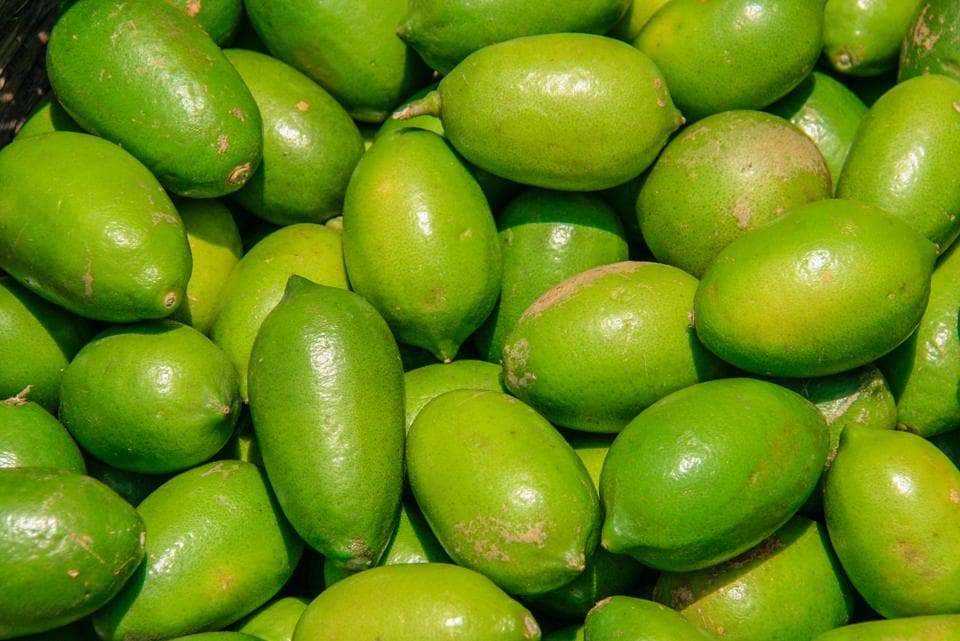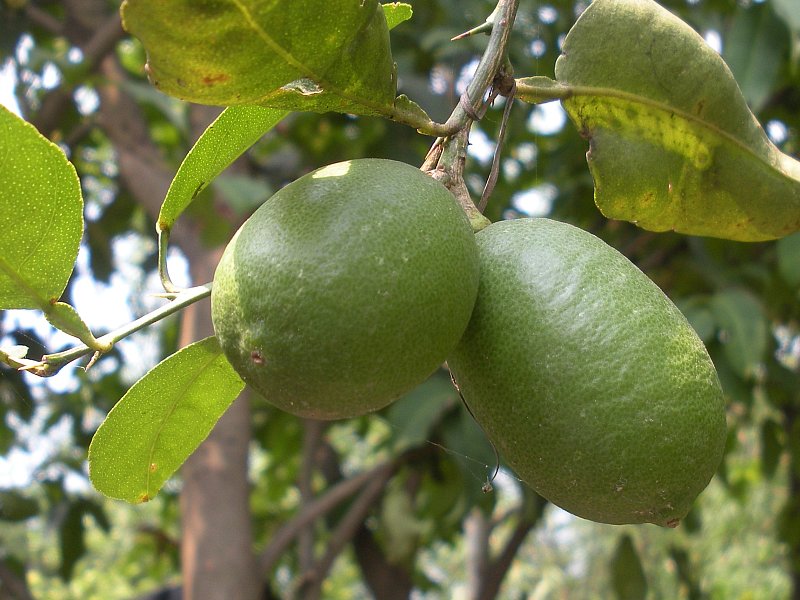About The Author
Hello! From Chuchura (in Hooghly District) and a foodie, I created this blog with a mission to preserve the food of the land; with a message to encourage and promote clean and real food. I hope you enjoy and gain out of this blog, happy reading!
Looking forward to read and hear your feedback.
Where’s the gondhoraj lebu with dal? I asked Maa.
It was sweltering hot outside and we had sat down for lunch (remember we had no AC in those days). Thanks to the unbearable heat, Maa had prepared just biulir dal (urad dal or black gram) and aloo posto (a curry made with cubed potatoes and poppy seed paste).
As Maa served the rice and I figured out what the menu was, I enquired for gondhoraj lebu; because without it the lunch would look so incomplete and dull.
Welcome to the world of gondhoraj lebu, Bengal’s dearest and perhaps India’s only answer to the kaffir lime.
What is Gondhoraj Lebu?
Lebu is lime (or lemon in India). The word gondhoraj means ‘king of aroma’ or ‘king of fragrance’. Gondhoraj lebu is a fragrant lime whose flavor quotient has earned it the title of a king.
The lemon has a hard skin, lower juice content; however it compensates for the lack of it with the rich refreshing aroma.

It is oblong and scarce in juice, cut into longish quarters and gently pressed to extract a few drops of ambrosia.
Don’t Squish Too Hard (Warning!)
Gondhoraj lime is high on aroma and low on juice content. Squishing the lime harder to extract more juice can result bitterness
The aroma from a few drops of the actual juice is strong enough to waft around the house inviting all to the dining table and sufficient to pep up the dullest of dal and vegetable curries.
Gondhoraj Lebu Origin
Gondhoraj lebu originates in Sylhet and the hills of Chittagong, Bangladesh. It is a close cousin of the common lemon found within India.
This is actually a ‘Rangpur’ lime which is a cross between a lime and a mandarin orange
Where is Gondhoraj Lebu Available Today?
Today it is grown in the Bengal subcontinent – West Bengal in India and Bangladesh.
While multiple effort has been made to grow it outside the region, the efforts have never succeeded. It grows only and best in the soil of Bengal.
The Leaves of Gondhoraj Lebu
As a kid, I used to go for swimming classes. On the way there used to be a full-grown ‘gondhoraj lebu’ tree in the neighborhood.
I remember plucking a couple of leaves, use both the hands to tear them into two-three pieces, sniffing and enjoying the aroma while trudging along to the swimming club which was almost a kilometer away.
Bengalis use gondhoraj lebu leaves for cooking as well and following are just a handful of examples.
Panta Bhaat
Rice cooked, soaked and fermented in water is a summer favorite across villages in Bengal.
In order to flavor and break the monotony, many also prefer to squash a couple of gondhoraj lebu leaves in the fermented rice making it an aromatic experience.
Other ingredients may also be added like roasted red chilis, curd, etc.
Dried Fish (Shutki)
The leaves of gondhoraj are squashed into shredded shutki macch along with loads of green chilis for a memorable shutki experience.
Fish/Chicken Curry with Gondhoraj Lebu Leaves
Cook your fish curry with onion, garlic, ginger and spices like you would normally do.
While the fish simmers, add the leaves towards the end and allow it to simmer for a minute and then switch off the flame.
For best results, tear up the leaves before adding.
The subtle freshness from the aroma of the gondhoraj leaves makes the fish curry stand out.
Lebu Patar Tawk
A tawk is a Bengali term for a runny/watery chutney. Usually sour in taste, many also prefer it to be a combination of sweet and sour.
This tawk is made from tamarind. Fresh tamarind is made into a paste. Alternatively, dried tamarind can be soaked in a little water for an hour.
To make this tawk, heat oil in a wok and add mustard seeds as tempering. Once the mustard seeds start spluttering, add in the tamarind paste. Also add turmeric powder, salt, jaggery (preferably, or sugar) and mix well. Next add water and allow the mixture to boil till it attains a uniform consistency. Tear up few gondhoraj leaves and throw in. Mix and allow to simmer for half a minute. Switch off the flame. Serve chilled for best flavors.
The end result is a gastronomical and aromatic delight.
Dishes Cooked with Gondhoraj Lebu
Several dishes are prepared with gondhoraj lime as an ingredient. A few notable ones are listed below.
Quarter of a gondhoraj lebu when squished into a mix of steaming hot rice and golden(shona) moong dal with jhuri aloo bhaja (crispy potato fries) as an accompaniment makes for a perfect comfort meal.
Gondhoraj Salad
You may squeeze in juice from gondhoraj lime and bits of the lime zest to add a unique dimension of the fresh aroma to the humble salad.
Off Topic – Remember: Ayurveda does not recommend eating raw vegetables. Avoid if you have skin problems.
Carelessly chopped cucumbers and onions with a bit of salt (preferably black salt) and few drops from the gondhoraj lebu does wonders. Many also prefer adding the zest of the lemon skin for the added aroma.
Gondhoraj Ghol
Ghol is the Bengali term for a watery lassi. Ghol has butermilk consistency.
Curd is blended with salt, sugar and water/ice to make a ghol. Juice and zest from gondhoraj lime is added to the ghol and immediately served to the guests.
Off Topic – Remember: Buttermilk is not curd plus loads of water. And certainly this way of making buttermilk is devoid of any health benefits. Butter milk is the liquid left behind in the process of butter being churned out of curd. This is also part of the process of making the real desi ghee.
Gondhoraj Murgi
You may not bat an eyelid when a humble chicken curry is served to you. You sure will, when served a gondhoraj murgi.
Chicken is cooked in a curd based sauce (optionally) along with spices and chilis and gondhoraj lime leaves and juice is used to instill its flavor in the gravy. Subtle, yet noticeable and makes for a wonderful summer lunch!
Gondhoraj Bhetki
Juice from gondhoraj lime and lime zest is required for this dish.
Kolkata Bekti is marinated with a blend of spices like ginger, garlic, green chilis and lime juice. The marinated fish is added to a second marinade which contains ginger, garlic, green chilis, curd, lemon zest and mustard oil.
The fish is then added to a pan with smoking mustard oil. The remaining marinate is poured over. Allow the fish to cook till done.
To quote Anjan Chatterjee’s article “Scent of a Lemon” published in the Telegraph – “Gondhoraj Bekti, an old favourite with a twist, seemed a good place to start. Rub a fresh and firm Calcutta Bekti with a light blend of spices. And infuse it with a few drops of gondhoraj. The royal transformation hits some deep olfactory region in the brain and lingers right up there for a long time afterwards. While the palate receives the full flavour of the lemon-fish, head on. And swoons!“
Phuchka
I have traveled outside Bengal, have tried gupchup/pani puri/golgappa (as they are called locally) and have always missed that distinct aroma that hits you once you sip the water (left over in the tiny container that can house one phuchka) after having tucked the phuchka in.
If you are in Bengal, take a peek into the container that houses the spicy, tangy & aromatic water. You will find the quarterly cut, oblong shaped gondhoraj slices floating on top with a handful of the squashed gondhoraj leaves.
Kolkata’s phuchka is also indebted to the gondhoraj.
Gondhoraj Momo & Kathi Rolls
Both are relatively new entriants to the Kolkata’s street food scene.
The intriguing factor that draws the crowd is also the green hue of the momos and rolls. In both cases, the green rind of the gondhoraj is blended to a smooth paste and kneaded into the dough to get this color.
The King & Kingmaker – Last Words
The gondhoraj lebu is the king of its kingdom and also the kingmaker when it comes to Bengali cuisine.
A few drops from a gondhoraj lebu can resurrect an entire meal even when it is the basic stuff. It wins over the monotony of the same-everyday-food through its heavenly aroma.
From its leaves squashed into curries to the zest and nectar used to flavor curries and dals, Gondhoraj lebu certainly hits the jackpot with full marks in versatility.
What is your memory of gondhoraj lebu?


Pingback: Machher Matha Diye Moong Dal - A Lentil Based Bengali Feast Special
Good to know.